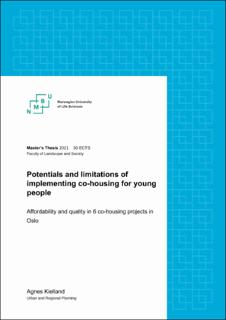| dc.description.abstract | Housing experiences of young people have been increasingly problematic since the Global Financial Crisis. The lack of adequate and affordable housing in both the rental and homeownership markets urgently calls for new, alternative housing solutions.
In Oslo, issues of accessing the homeownership market for young people is particularly pressing. Looking to Europe for guidance, scholars and policy makers have expressed a renewed interest in co-housing as an alternative housing provider. This study aims to identify the current limitations and potentials for developing co-housing in Oslo, as a possible way to provide more affordable homeownership for young people. In addition, the study investigates whether co-housing can secure quality, meanwhile providing affordability.
In order to identify the current limitations and potentials of co-housing in Oslo the study has applied qualitative methods in the form of a multiple case study approach. Interviews were held with seven key informants connected to six co-housing projects in Oslo. As the existing situation of co-housing in Oslo is fairly limited, the cases analyzed include existing, in process and stopped projects.
The results showed that the most affordable projects have the hardest time with being realized. One reason is that they challenge local regulation plans, which aim at securing quality. The existing projects, on the other hand, provide high qualities, but lack affordable options. As such, the current co-housing market in Oslo is way too limited to offer affordable homeownership for young people in Oslo.
The study proposes one possible solution for the implementation of more affordable co-housing projects in Oslo. Securing quality by demanding a certain amount of common spaces in projects that reduce the size of private units, but challenges local regulations plans, can prove effective. Future research might look more into the effects of such a tool. Lastly, the study has identified a reemerged interest in co-housing as a concept in Oslo, and explores the few, but innovative pilots that pushes the agenda of co-housing in Oslo forward. | en_US |

